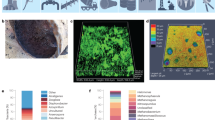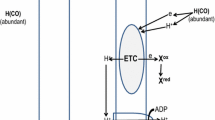Abstract
In this review, we focus on how biofilms comprising iron-respiring bacteria influence steel corrosion. Specifically, we discuss how biofilm growth can affect the chemistry of the environment around the steel at different stages of biofilm development, under static or dynamic fluid regimes. We suggest that a mechanistic understanding of the role of biofilm metabolic activity may facilitate corrosion control.


Similar content being viewed by others
References
Angell P (1999) Understanding microbially influenced corrosion as biofilm-mediated changes in surface chemistry. Curr Opin Biotechnol 10:269–272
Arnold R, DiChristina T, Hoffman M (1988) Reductive dissolution of Fe(III) oxides by Pseudomonas sp. 200. Biotechnol Bioeng 32:1081–1096
Beliaev AS, Saffarini DA (1998) Shewanella putrefaciens mtrB encodes an outer membrane protein required for Fe(III) and Mn(IV) reduction. J Bacteriol 180:6292–6297
Beliaev AS, Saffarini DA, McLaughlin JL, Hunnicutt D (2001) MtrC, an outer membrane decahaem c cytochrome required for metal reduction in Shewanella putrefaciens MR-1. Mol Microbiol 39:722–730
Beliaev A, et al (2002) Gene and protein expression profiles of Shewanella oneidensis during anaerobic growth with different electron acceptors. OMICS 6:39–60
Caccavo F Jr, Das A (2002) Adhesion of dissimilatory Fe(III)-reducing bacteria to Fe(III) minerals. Geomicrobiol J 19:161–177
Caccavo F Jr, Blakemore RP, Lovley DR (1992) A hydrogen-oxidizing, Fe(III)-reducing microorganism from the Great Bay estuary, New Hampshire. Appl Environ Microbiol 58:3211–3216
Childers SE, Ciufo S, Lovley DR (2002) Geobacter metallireducens accesses insoluble Fe(III) oxide by chemotaxis. Nature 416:767–769
Costerton JW, Lewandowski Z, Caldwell DE, Korber DR, Lappin-Scott HM (1995) Microbial biofilms. Annu Rev Microbiol 49:711–745
Das A, Caccavo F Jr (2001) Adhesion of the dissimilatory Fe(III)-reducing bacterium Shewanella alga BrY to crystalline Fe(III) oxides. Curr Microbiol 42:151–154
Dawood Z, Brozel VS (1998) Corrosion-enhancing potential of Shewanella putrefaciens isolation from industrial cooling waters. J Appl Microbiol 84:929–936
DiChristina T, Moor CM, Haller CA (2002) Dissimilatory Fe(III) and Mn(IV) reduction by Shewanella putrefaciens requires ferE, a homolog of the pulE (gspE) type II protein secretion gene. J Bacteriol 184:142–151
Dubiel M, Hsu CH, Chien CC, Mansfeld F, Newman DK (2002) Microbial iron respiration can protect steel from corrosion. Appl Environ Microbiol 68:1440–1445
Emde K, Smith D, Facey R (1992) Initial investigation of microbially influenced corrosion (MIC) in a low-temperature water distribution-system. Water Res 26:169–175
Glasauer S, Langley S, Beveridge TJ (2001) Sorption of Fe (hydr)oxides to the surface of Shewanella putrefaciens: cell-bound fine-grained minerals are not always formed de novo. Appl Environ Microbiol 67:5544–5550
Hamilton WA (1998) Bioenergetics of sulphate-reducing bacteria in relation to their environmental impact. Biodegradation 9:202–212
Hamilton WA (2003) Microbially influenced corrosion as a model system for the study of metal microbe interactions: a unifying electron transfer hypothesis. Biofouling 19:65–76
Hernandez ME, Newman DK (2001) Extracellular electron transfer. Cell Mol Life Sci 58:1562–1571
Hernandez G, Kucera B, Thierry D, Pedersen A, Harmansson M (1994) Corrosion inhibition of steel by bacteria. Corrosion 50:603–608
Jayaraman A, Cheng ET, Earthman JC, Wood TK (1997a) Axenic aerobic biofilms inhibit corrosion of SAE 1018 steel through oxygen depletion. Appl Microbiol Biotechnol 48:11–17
Jayaraman A, Earthman JC, Wood TK (1997b) Corrosion inhibition by aerobic biofilms on SAE 1018 steel. Appl Microbiol Biotechnol 47:62–68
Jones DA (1996) Principles and prevention of corrosion, 2nd edn. Prentice Hall, Upper Saddle River, N.J.
Jones DA, Amy PS (2000) Related electrochemical characteristics of microbial metabolism and iron corrosion. Ind Eng Chem Res 39:575–582
Jones DA, Amy PS (2002) A thermodynamic interpretation of microbiologically influenced corrosion. Corrosion 58:638–645
Kjelleberg S, Molin S (2002) Is there a role for quorum sensing signals in bacterial biofilms? Curr Opin Microbiol 5:254–258
Koch GH, Brongers MPH, Thompson NG, Virmani YP, Payer JH (2001) Corrosion costs and preventative strategies in the United States. (Report by CC Technologies Laboratories to the Federal Highway Administration. Report FHWA-RD-01-156) Office of Infrastructure Research and Development, Washington, D.C.
Lee W, Andowski ZL, Nielsen PH, Hamilton WA (1995) Role of sulfate-reducing bacteria on corrosion of mild steel: a review. Biofouling 8:165–194
Lewandowski Z, Lee WC, Characklis WG, Little B (1989) Dissolved oxygen and pH microelectrode measurements at water-immersed metal surfaces. Corrosion 45:92–98
Little B, Ray R (2002) A perspective on corrosion inhibition by biofilms. Corrosion 58:424–428
Little BJ, Wagner PA (1997) Spatial relationships between bacteria and mineral surfaces. Rev Miner 35:123–159
Little B, Wagner PA, Mansfeld F (1997) Microbiologically influenced corrosion. NACE International, Houston, Tex.
Little B, et al (1998) The role of biomineralization in microbiologically influenced corrosion. Biodegradation 9:1–10
Lovley DR (1991) Dissimilatory Fe(III) and Mn(IV) reduction. Microbiol Rev 55:259–287
Lovley DR (2002) Dissimilatory metal reduction: from early life to bioremediation. ASM News 68:231–237
Lovley DR, Coates JD (2000) Novel forms of anaerobic respiration of environmental relevance. Curr Opin Microbiol 3:252–256
Lovley DR, Phillips EJP (1988) Novel mode of microbial energy metabolism: organic carbon oxidation coupled to dissimilatory reduction of iron or manganese. Appl Environ Microbiol 54:1472–1480
Lovley DR, Coates JD, Blunt-Harris EL, Phillips EJP, Woodward JC (1996) Humic substances as electron acceptors for microbial respiration. Nature 382:445–448
Lower SK, Hochella MF Jr, Beveridge TJ (2001) Bacterial recognition of mineral surfaces: nanoscale interactions between Shewanella and alpha-FeOOH. Science 292:1360–1363
Magnuson TS, et al (2001) Isolation, characterization and gene sequence analysis of a membrane-associated 89 kDa Fe(III) reducing cytochrome c from Geobacter sulfurreducens. Biochem J 359:147–152
Myers CR, Myers JM (1993) Ferric reductase is associated with the membranes of anaerobically grown Shewanella putrefaciens MR-1. FEMS Microbiol Lett 108:15–22
Myers CR, Nealson KH (1988) Bacterial manganese reduction and growth with manganese oxide as the sole electron acceptor. Science 240:1319–1321
Nevin KP, Lovley DR (2002a) Mechanisms for accessing insoluble Fe(III) oxide during dissimilatory Fe(III) reduction by Geothrix fermentans. Appl Environ Microbiol 68:2294–2299
Nevin KP, Lovley DR (2002b) Mechanisms for Fe(III) oxide reduction in sedimentary environments. Geomicrobiol J 19:141–159
Newman DK, Kolter R (2000) A role for excreted quinones in extracellular electron transfer. Nature 405:94–97
Obuekwe CO, Westlake DWS, Cook FD, Costerton JW (1981a) Surface changes in mild steel coupons from the action of corrosion-causing bacteria. Appl Environ Microbiol 41:766–774
Obuekwe CO, Westlake DWS, Plambeck JA, Cook FD (1981b) Corrosion of mild steel in cultures of ferric iron reducing bacterium isolated from crude oil. I. Polarization characteristics. Corrosion 37:461–467
Obuekwe CO, Westlake DWS, Plambeck JA, Cook FD (1981c) Corrosion of mild steel in cultures of ferric iron reducing bacterium isolated from crude oil. II. Mechanism of anodic depolarizaiton. Corrosion 37:632–637
O′Toole G, Kaplan HB, Kolter R (2000) Biofilm formation as microbial development. Annu Rev Microbiol 54:49–79
Potekhina JS, et al (1999) Role of microorganisms in corrosion inhibition of metals in aquatic habitats. Appl Microbiol Biotechnol 52:639–646
Pratt LA, Kolter R (1999) Genetic analyses of bacterial biofilm formation. Curr Opin Microbiol 2:598–603
Rousset M, et al (1998) New shuttle vectors for the introduction of cloned DNA in Desulfovibrio. Plasmid 39:114–122
Stewart PS (2003) Diffusion in biofilms. J Bacteriol 185:1485–1491
Stoodley P, Sauer K, Davies DG, Costerton JW (2002) Biofilms as complex differentiated communities. Annu Rev Microbiol 56:187–209
Sutherland IW (2001) The biofilm matrix—an immobilized but dynamic microbial environment. Trends Microbiol 9:222–227
Tugel JB, Hines ME, Jones GE (1986) Microbial iron reduction by enrichment cultures isolated from estuarine sediments. Appl Environ Microbiol 52:1167–1172
Turick CE, Tisa LS, Caccavo F Jr (2002) Melanin production and use as a soluble electron shuttle for Fe(III) oxide reduction and as a terminal electron acceptor by Shewanella algae BrY. Appl Environ Microbiol 68:2436–2444
Wall JD, Murnan T, Argyle J, English RS, Rapp-Giles BJ (1996) Transposon mutagenesis in Desulfovibrio desulfuricans: development of a random mutagenesis tool from Tn7. Appl Environ Microbiol 62:3762–3767
Acknowledgements
We thank members of the Newman Laboratory for helpful discussions. This material is based upon work supported by the National Science Foundation under a grant awarded in 2001 to A.K.L. This work was supported by grants from the Office of Naval Research and the Luce Foundation to D.K.N.
Author information
Authors and Affiliations
Rights and permissions
About this article
Cite this article
Lee, A.K., Newman, D.K. Microbial iron respiration: impacts on corrosion processes. Appl Microbiol Biotechnol 62, 134–139 (2003). https://doi.org/10.1007/s00253-003-1314-7
Received:
Revised:
Accepted:
Published:
Issue Date:
DOI: https://doi.org/10.1007/s00253-003-1314-7




